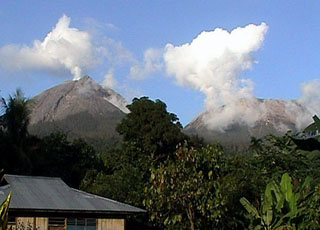Report on Lewotobi (Indonesia) — 21 May-27 May 2025
Smithsonian Institution / US Geological Survey
Weekly Volcanic Activity Report, 21 May-27 May 2025
Managing Editor: Sally Sennert.
Please cite this report as:
Global Volcanism Program, 2025. Report on Lewotobi (Indonesia) (Sennert, S, ed.). Weekly Volcanic Activity Report, 21 May-27 May 2025. Smithsonian Institution and US Geological Survey.
Lewotobi
Indonesia
8.542°S, 122.775°E; summit elev. 1703 m
All times are local (unless otherwise noted)
In a special 25 May report the Pusat Vulkanologi dan Mitigasi Bencana Geologi (PVMBG) stated that eruptive activity at Lewotobi Laki-laki had decreased after the larger 18 May eruption and subsequent ash plumes and crater incandescence observed during 19-20 May. Seismicity indicated decreasing surface activity and magmatic recharge at depth during 20-25 May, and tiltmeter data indicated deflation. No rumbling was heard and no incandescence was visible at the summit. An eruptive event at 0649 on 23 May produced a dense gray ash plume that rose around 300 m above the summit and drifted SW and W. Later that day a drone flight over the summit revealed that dark lava had filled the crater, covering about 87,000 square meters. At 0900 on 25 May the Alert Level was lowered to 3 on a scale of 1-4) and the public was warned to stay 6 km away from the center of Laki-laki. White steam-and-gas plumes rose as high as 800 m above the crater rim and drifted in various directions during 25-28 May.
Geological Summary. The Lewotobi edifice in eastern Flores Island is composed of the two adjacent Lewotobi Laki-laki and Lewotobi Perempuan stratovolcanoes (the "husband and wife"). Their summits are less than 2 km apart along a NW-SE line. The conical Laki-laki to the NW has been frequently active during the 19th and 20th centuries, while the taller and broader Perempuan has had observed eruptions in 1921 and 1935. Small lava domes have grown during the 20th century in both of the summit craters, which are open to the north. A prominent cone, Iliwokar, occurs on the E flank of Perampuan.
Source: Pusat Vulkanologi dan Mitigasi Bencana Geologi (PVMBG, also known as CVGHM)

